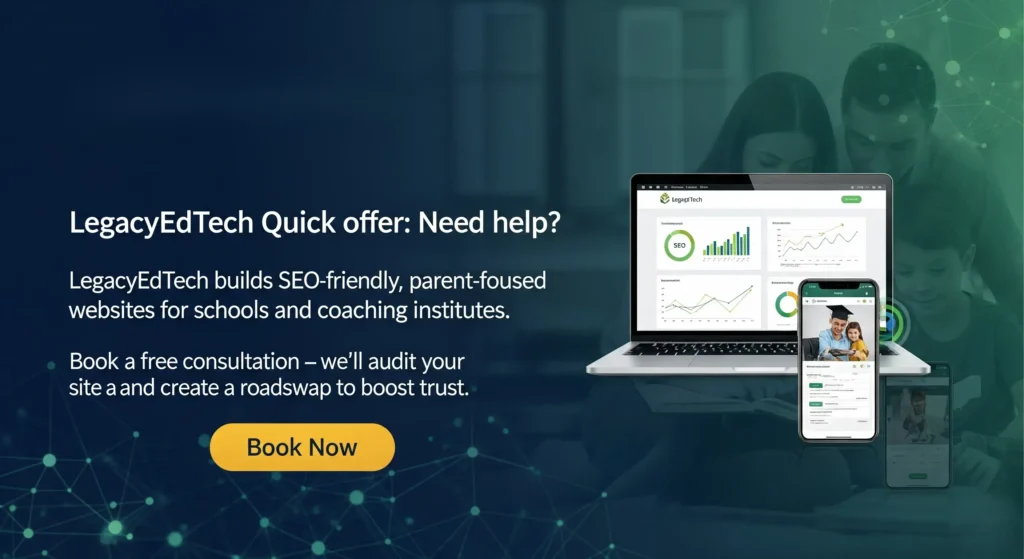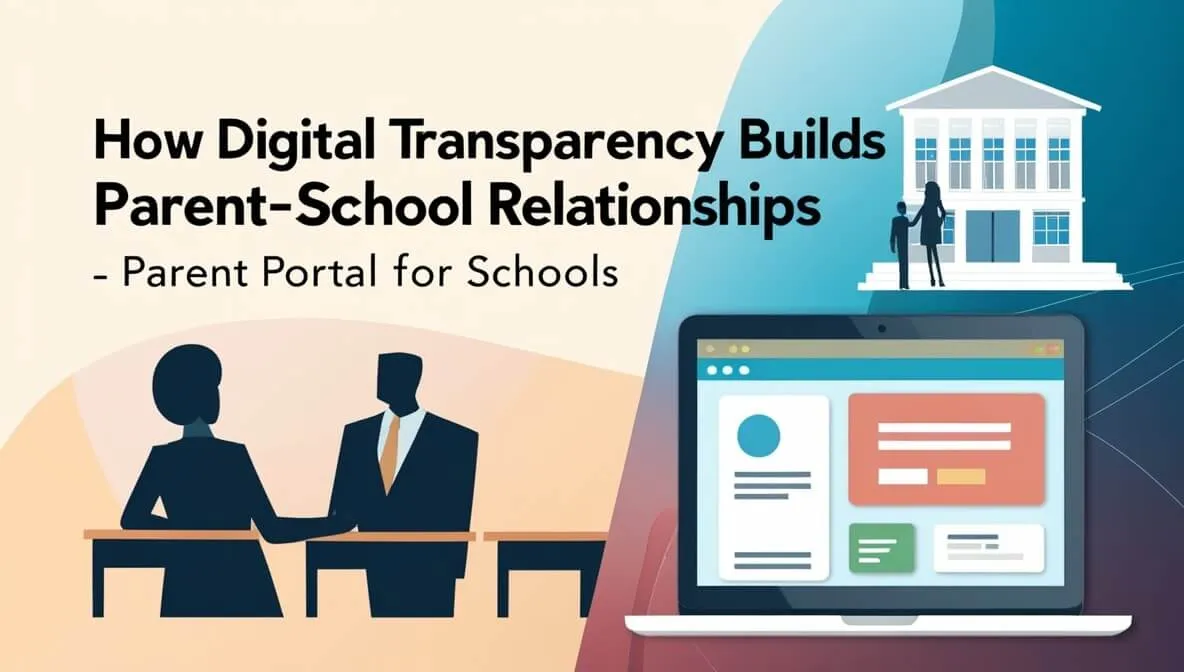Table of Contents
- Introduction
- Why Digital Transparency Matters Today
- What is a Parent Portal for Schools?
- How a Parent Portal for Schools Builds Trust
- Key features of an effective Parent Portal for Schools
- Implementation roadmap: Launching a parent portal for schools
- Best practices for adoption and engagement
- Measuring impact: KPIs that show the parent portal for schools is working
- Tackling common concerns: Privacy, Overload, and Equity
- Examples & mini case studies
- Comparison: Paper vs. Parent Portal for Schools
- Content examples: Templates for teacher messages
- Frequently Asked Questions (FAQs)
- Conclusion — Adopt a Parent Portal for Schools to Build Trust
- Ready to strengthen parent-school relationships?
Introduction
Parents expect clear, timely information about their child’s learning. Schools struggle to deliver consistent updates without overwhelming staff. That gap breeds mistrust, missed opportunities, and friction. A parent portal for schools — a secure, user-friendly digital gateway — solves this by delivering transparent, real-time information. With the right tools, schools reduce confusion, save staff time, and strengthen relationships with families through clear, regular, and two-way communication (see parent portal benefits).
This post explains how digital transparency builds parent-school relationships, shows concrete features and workflows, and gives a practical checklist so your school or coaching institute can implement a parent portal for schools successfully.
Why Digital Transparency Matters Today
Parents now use smartphones and expect instant access. During and after COVID, the expectation rose: parents want to track attendance, assignments, fees, behaviour notes, and school announcements. When schools are transparent, parents feel involved. When they are not, distrust grows.
Key consequences of poor transparency:
- Missed interventions when a student begins to struggle.
- Parent anxiety and repeated calls/meetings that consume staff time.
- Perception gaps that harm school reputation.
By contrast, digital transparency through a parent portal for schools:
- Provides evidence (data) rather than anecdote.
- Makes communication predictable and measurable.
- Empowers parents to support learning at home.
Transitioning to digital systems is not about surveillance. It’s about clarity. Done well, a parent portal for schools balances timely updates with respect for privacy.
What is a Parent Portal for Schools?
A parent portal for schools is a secure section of a school’s management system or app where parents access student-specific information: grades, attendance, homework, fee invoices, notifications, and messages from teachers. It centralises communication.
Core components:
- Login & authentication
- Dashboard with key metrics
- Gradebook and assignment tracker
- Attendance and safety alerts
- Fee payment and receipt history
- Messaging and conference scheduling
- Document library (reports, permission slips)
A modern parent portal for schools integrates with SIS (Student Information Systems), LMS (Learning Management Systems), and payment gateways, offering a single source of truth for families.
How a Parent Portal for Schools Builds Trust
Transparency builds trust, and trust builds partnership. Here’s how a parent portal for schools directly strengthens relationships:
1. Real-time academic visibility
Parents see grades and feedback as teachers update them. No more surprises at report card time. Real-time updates let parents act early.
2. Predictable communication rhythms
Scheduled updates — weekly progress snapshots, monthly behaviour summaries — reduce ad hoc, stressful phone calls. Consistency equals reliability.
3. Two-way communication and collaboration
Messaging, meeting booking, and shared notes turn unilateral announcements into conversations. When parents can ask questions or propose solutions, partnership grows.
4. Financial transparency and convenience
Online fee invoices and payment histories reduce billing disputes and confusion. Clear receipts and automated reminders build confidence and reduce administrative workload.
5. Safety and attendance visibility
Immediate attendance alerts reassure parents about safety. When a child is absent, parents are notified early — a critical trust builder.
6. Evidence-based conversations
Teachers and parents can look at the same data during conferences. That shared view reduces defensiveness and focuses the conversation on solutions.
Key features of an effective Parent Portal for Schools
Not all portals are equal. Use this checklist to evaluate or brief vendors.
| Feature | Why it builds transparency | Example / Benefit |
|---|---|---|
| Real-time gradebook | Shows current performance | Parents see homework scores and teacher feedback immediately |
| Attendance & SMS alerts | Keeps families informed about safety | Instant notice when a student is marked absent |
| Messaging & meeting scheduler | Enables two-way dialogue | Parents book parent-teacher meetings without phone tag |
| Payment gateway & invoices | Clear financial records | Parents view invoices, pay fees, access receipts |
| Document vault | Central access to forms and reports | Permission slips, report cards, policies in one place |
| Role-based access | Protects privacy | Teachers, admins, and parents see only relevant info |
| Multilingual UI | Inclusivity | Families read updates in their preferred language |
| Mobile app + web access | Accessibility | Use on Android/iOS and desktop |
| Analytics dashboard | Measures engagement | See active users, unread messages, and issues flagged |
When you choose a platform, prioritise security (encryption, GDPR/FERPA/India-specific compliance), usability (clear UI), and integration capability.
Implementation roadmap: Launching a parent portal for schools
A staged approach reduces friction and builds adoption.
Phase 1 — Prepare
- Audit existing systems (SIS, LMS).
- Define data flows: who updates grades, attendance, notices.
- Create a privacy and consent policy.
- Identify pilot classes or grades.
Phase 2 — Pilot
- Launch with one grade, 6–8 weeks.
- Train teachers and admin staff.
- Provide parents with quick-start guides and a helpline.
- Collect feedback and fix UX holes.
Phase 3 — Full rollout
- Stagger rollout by section.
- Use onboarding campaigns: SMS, WhatsApp, newsletters.
- Monitor engagement metrics.
Phase 4 — Iterate
- Add features (homework photos, behaviour logs) based on feedback.
- Re-train staff yearly.
Quick checklist
- Choose vendor or build in-house
- Data security compliance checklist complete
- Pilot plan and training schedule
- Parent onboarding materials created
- Monitoring KPI dashboard ready

Best practices for adoption and engagement
High adoption is critical. These tactics help:
- Keep messages brief and scheduled. Parents prefer predictable summaries.
- Train teachers in concise digital communication. Short, actionable messages work best.
- Use plain language. Avoid school jargon.
- Highlight wins: share student achievements regularly.
- Offer multilingual support and tech help sessions.
- Use push notifications sparingly — prioritize critical alerts.
Measuring impact: KPIs that show the parent portal for schools is working
Track these metrics to prove ROI and show improved parent-school relationships:
- Parent login rate (weekly/monthly active users)
- Message response time (average time teachers take to reply)
- Reduction in parent calls/emails about routine questions
- Meeting attendance rate for parent-teacher conferences
- Fee collection timeliness and reduction in billing disputes
- Parent satisfaction score (short surveys)
A basic dashboard that collects these KPIs helps leadership make data-driven decisions.
Tackling common concerns: Privacy, Overload, and Equity
Digital transparency raises valid concerns. Address them head-on.
Privacy & compliance
- Use role-based access and encryption.
- Store data in compliant servers. In India, review local regulations (e.g., data localisation guidelines) and school board policies.
- Publish clear data-use and retention policies.
Information overload & anxiety
- Offer digest settings: daily/weekly summaries.
- Teach parents what to track and what not to worry about.
- Encourage teachers to use comments focused on progress and actions, not minutiae.
Digital divide
- Provide alternative channels for parents without smartphones (printed reports, SMS summaries).
- Offer onsite kiosks during parent nights.
When schools proactively address these concerns, parents trust the system more and use it thoughtfully.
Examples & mini case studies
Example 1 — The weekly snapshot
A medium-sized school launched a weekly summary card sent every Friday via the parent portal for schools. The card showed:
- Attendance status for the week
- Top 3 completed assignments
- One skill the student improved on
Result: Teachers received fewer routine progress calls. Parents felt more connected.
Example 2 — Fees & transparency
A coaching institute added a fee ledger to the portal. Parents could see installment schedules and receipts. Result: Fee-related queries dropped by 65% in one term.
Example 3 — Behaviour notes with solutions
Instead of terse behaviour logs, teachers attached next steps and offered a 5-minute parent chat option. Result: Better parent collaboration and fewer disciplinary escalations.
Comparison: Paper vs. Parent Portal for Schools
| Problem | Paper / Phone | Parent portal for schools (digital) |
| Late fee disputes | Frequent | Clear ledger and receipts reduces disputes |
| Ad hoc parent calls | High | Scheduled updates lower call volume |
| Conference prep | Time-consuming | Shared data focuses meeting time on learning goals |
| Accessibility | Limited | Mobile + web access; multilingual support |
Content examples: Templates for teacher messages
Short progress update (50–70 words)
“Hi [Parent name], [Student] submitted 2/3 assignments this week. Math score improved from 62% to 74% on the recent test. Suggested next step: practice 10 minutes of multiplication drills daily. — Ms. Rao”
Absence alert (SMS + portal)
“[Student] is marked absent today (10 Sept). If this is unexpected, please reply or call the office.”
Meeting invite
“We’d like a 15-minute meeting to discuss [student]’s reading goals. Please choose a slot here: [link].”
These templates keep communication concise and action-oriented.
Frequently Asked Questions (FAQs)
Q1: What exactly is a “parent portal for schools” and why should my school adopt it?
A1: A parent portal for schools is a secure digital hub where parents access grades, attendance, invoices, and messages. It improves transparency, reduces administrative noise, and helps parents support learning at home. (See parent portal benefits.)
Q2: Will a parent portal increase teacher workload?
A2: Initially there’s setup and training. But with clear templates, scheduled updates, and automation (auto-notices, report generation), portals often reduce repetitive work and call volume.
Q3: How does a parent-teacher communication app differ from a parent portal for schools?
A3: A parent-teacher communication app may focus on messaging and classroom updates. A parent portal for schools is broader: grades, payments, documents, and analytics. The two can be integrated for a complete solution.
Q4: What about privacy and legal compliance?
A4: Choose systems with encryption, role-based access, and compliance with regulations (FERPA-equivalent in your country). Publish a clear privacy policy and consent forms for parents.
Q5: How do we encourage parents to use the portal?
A5: Run a short launch campaign. Offer training, create one-page quick-start guides, and highlight immediate benefits (fees, attendance alerts, progress snapshots).
Conclusion — Adopt a Parent Portal for Schools to Build Trust
Digital transparency is not optional anymore. A well-implemented parent portal for schools replaces uncertainty with clarity. It reduces administrative friction, supports evidence-based parent-teacher conversations, and most importantly, builds the trust that every effective school-family partnership needs.
If your school wants to strengthen relationships with families, start with a pilot. Choose a portal that prioritises security, usability, and clear insights. The payoff is measurable: higher parent satisfaction, fewer disputes, and better coordinated student support.
Focus keyword (repeated): parent portal for schools
Ready to strengthen parent-school relationships?
LegacyEdTech can help your school or coaching institute evaluate and implement the right parent portal for schools. Book a free consultation to map requirements, pilot the portal, and train your staff so you get fast adoption and visible impact. Email us at legacyedtech.in@gmail.com or book your free consultation right now.







